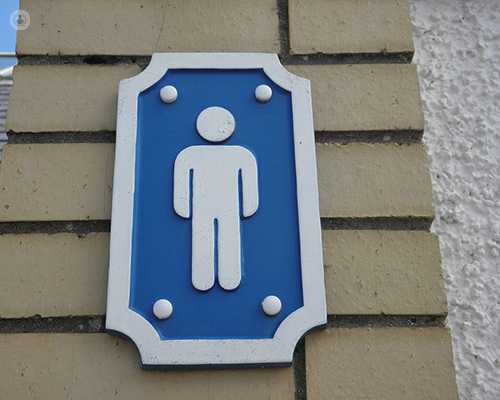Treating benign prostatic hyperplasia (BPH)
Written by:The prostate is an organ that sits in the base of the bladder in men, surrounding the urethra. Its function is to add components to the semen to increase the chance of a sperm fertilising an ovum. With increasing age, the prostate changes and there are alterations in the way the prostate is made up with different amounts of fibrous and muscular tissue. This increase in size and increase in fibrous muscular tissue is known as benign prostatic hyperplasia or BPH. Mr Jeremy Crew, a leading urologist, discusses the treatment options available for BPH.

When do men get BPH?
You tend to find that the first evidence of BPH in men is at about 40 years of age and it increases in size beyond that. The approximate increase in size is about 10% every five years. What this means, is that by the age of about 80 years old, about 80% of men will have evidence of BPH.
How does an enlarged prostate affect urination?
An enlarged prostate can inhibit the passage of urine through the urethra. It does this in two ways.
- Firstly, as the prostate increases in size, it can abut on the urethra and occlude the urethra. This is called a static component of obstruction.
- There is also a dynamic component of this obstruction in that the fibrous and muscular tissues of the prostate can contract and compress the urethra and squeeze it shut.
These two components often work together as such that they inhibit the free passage of the urine along the urethra. This will manifest itself in symptoms such as:
- Poor flow of urine
- Intermittency of the passage of urine
- Hesitancy and difficulty starting to pass urine.
There is another effect that BPH can have in that, by obstructing the bladder, the bladder has to increase its pressure in order to overcome the obstructing prostate. What happens as a result of this is that bladder can become hyperactive and unstable. This will manifest itself in urinary symptoms of urinary frequency, urinary urgency and nocturia. In other words, getting up three or four times at night to pass urine.
What are the treatment options for BPH?
BPH may require no treatment at all and, really, the treatment depends on the presence of troublesome urinary symptoms.
The first step in management may be simple lifestyle changes:
- Cutting down the amounts of fluid you drink before you get to bed or long car journeys
- Cutting down the amount of caffeine and coffee you drink
The next step would be medication in the form of tablets. There are two main types of tablets that are offered for symptomatic BPH:
- Firstly, there is an alpha-blocker. An alpha-blocker, such as Tamsulosin, inhibits contraction of the smooth muscle within the prostate. This has an effect on the dynamic components of obstruction and may relieve some of the symptoms of obstruction.
- There is a second medication called 5-alpha-reductase inhibitors, such as finasteride. This has an effect on the static component of obstruction. They cause shrinkage of the prostate and relief of the static obstruction. It is important to be aware that this occurs via shrinkage of the prostate which may take three to six months to have its effect. Therefore, the effects of 5-alpha-reductase inhibitor medication are not overnight and may take a number of weeks before a symptomatic improvement is seen.
One of the problems with both of these medications is that they have side-effects, which some patients do not want to experience.
What about surgical treatments?
In a proportion of patients, further treatment may be required. We are fortunate that at the moment there are a number of different options that can be tried.
- Firstly, prostatic artery embolization. This is a procedure done in the radiology department where small pellets are placed into the arteries that are supplying the prostate, causing the prostate to shrink. This is done under local anaesthetic as an outpatient procedure.
- The second treatment option is called UroLift. This is done by urologists. It can be done with local or general anaesthetic. It involves inserting a tube up the urethra and using staples to staple the prostate open.
- The third one is a newer form of treatment called Rezum. Again, this is done by a urologist under local or general anaesthetic often as an outpatient or a day case procedure. It involves a telescope being inserted up the urethra to the prostate and using a tiny needle to inject steam into the prostate. The steam causes the prostatic cells to die and the prostate involutes, allowing the opening of the prostate. This improves voiding. One of the issues with this is that a patient would need to have a catheter following this procedure for two to five days while the inflammation in the prostate settles.
The advantage of all three of these treatments is that they are minimally-invasive and can often be done as a day case or under local anaesthetic.
However, there are cases where a more complete resection of the prostate is required. The standard way this is done is using electricity (transurethral resection of the prostate or TURP). This is done by urologist under general anaesthetic. It requires a two-night stay in hospital. With the advent and development of lasers, in my view, the TURP has been improved upon and now lasers are used to do the same procedure.
The standard one that I would use is called a Holmium laser enucleation of the prostate or HoLEP. This is done under general anaesthetic as an in-patient procedure. Although some patients can go home the same day, the majority are kept in overnight with a one-night stay in the hospital. The HoLEP is my chosen technique over the TURP because it does a more complete resection, there is less bleeding and the majority of patients can get home after a one-night stay in hospital.
Which is the best treatment for BPH?
It is not possible to say what the best treatment for BPH is, as this will differ from patient to patient. If treatment is required, fortunately, a number of different options are available which all have advantages and disadvantages. It is absolutely crucial that a patient is referred to a urologist to discuss these options.
The question will be what, of the options available, is best for an individual patient - and this will depend on a number of factors:
- Size and shape of the prostate
- General health and comorbidity of the patient
- The patient's wishes and desires
I think what is absolutely crucial in this day and age that patients get the opportunity to speak to a urologist who is knowledgeable about the full range of treatment options and is able to fully discuss these options in an open and honest way with the patients and with clinical equipoise.


